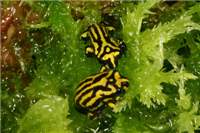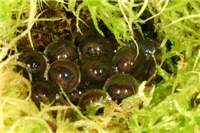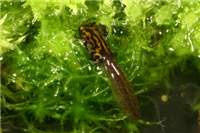Family
Hylidae
Genus
Pseudophryne
Species
corroboree
Threats/Control Methods - Regional
Decline in the sphagnum bogs and potentially the chytrid fungus. Climate change, increased UV radiation, over zealous controlled burn-offs earlier in the century may have altered some of the species natural habitats, Livestock access in previous years, development of the Snowy Hydro Scheme and the introduction of feral plant and animal species are all thought to have negatively impacted upon the species.
For more information on the Chytrid fungus © Link to fact sheet http://www.deh.gov.au/biodiversity/invasive/publications/c-disease/
Frogs drink and breathe through their skin and are very sensitive to chemicals in their environment. Where possible, you should not handle frogs, as the natural bacteria on your hands or chemicals such as sunscreen can damage their skin and cause illness or death.
Local/Urban Actions
Captive breeding programs as well as habitat protection exist in order to promote the long-term survival of the species.
Frog monitoring, under the Frogwatch Program, is run annually within the ACT, with monitoring done by volunteers from the general public over a two week period. The Frogwatch program provides training for community volunteers each October.For more information on Frogwatch contact:The ACT Frogwatch Coordinator, Ginninderra Catchment Group; Ph(02)62783309 oremail: [email protected]
Although it is unlikely that this species will be attracted to the urban backyard it is possible to attract other frog species. Urban backyards can become suitable habitats for frogs through simple landscaping techniques. The Australian National University and the Ginninderra Catchment Group have developed a guideline to help you encourage frogs into your backyard called [Link - Creating a Frog Friendly Habitat in the ACT Community]
Distinguishing Features
A small frog with distinctive yellow and black stripes, similar in appearance to those found on a zebra, covering the body. Exceedingly similar in appearance and call to its Northern cousin P. pengilleyi subtle differences in markings do exist. This Southern species has continuous black and yellow stripes, and white spots upon its chest, opposed to the Northern species on which the stripes are broken, and less yellow upon its body. In both species the call sounds like a nasal Ah-rurkk ... urkk ...urkk
Common name/s
Southern Corroboree Frog
Similar Species
Northern Corroboree frog (Pseudophyrne pengilleyi), Brown Toadlet (Pseudophyrne bibroni), Southern toadlet (Pseudophyrne dendyi)
Distribution
Only occurs in Kosciusko National Park in an area totalling around 400m2.
Country of Origin
Australia
Survey Techniques
The limited population and range of the species means that habitats in which this species occurs are often protected. For this reason call identification remains the safest way to identify the species, as not only does it not require vigorous searching but it also provides some protection to the habitat in which the species resides, as well as helping to prevent the spread of any diseases, such as the Chytrid fungus into its habitat.
Conservation (Pet/Pest) Status - National
In the 1980©s the species experienced a dramatic population decline leading onto many localised populations becoming extinct. Listed as Endangered under the Commonwealth Environment Protections and Biodiversity act (1999).
Conservation (Pet/Pest) Status - Regional
In 1996 a recovery plan for the species was designed and the first stages of implementation were begun. Listed as endangered under the NSW Threatened Species Conservation Act (1995).
LSCCES Population
Listed as Vulnerable under the Nature Conservation Act (1980).
Within the ACT captive breeding programs as well as monitoring are undertaken with respect to the Recovery Plan for the Southern Corroboree Frog (Pseudphryne corroboree).
Associated Vegetation Community
The species is associated with two distinct habitats, a breeding and a none-breeding habitat. When breeding the species is found in the aquatic environments within sphagnum bogs, tussock and heathland, within which species such as Spreading rope-rush (Emposidsma minus), peat moss (sphagnum cristatum), tussock grasses (Poa spp.), the rush (Restio australis), and the sedge (Carex gaudichaudiana) are often found. Otherwise, in the none-breeding season, the species resides in sub-alpine woodlands and heaths where species such as (Bossiaea foliosa), (Prostanthera cuneata), (Oxylobium spp.) and (Phebalium spp.) are common.
Limiting Resources
In the breeding season this species is only found in the sphagnum bogs of the snowy mountains, requiring such habitats for breeding. Naturally occurs at altitudes of between 1300-1760 metres. In order for the hatching a survival of tadpole a regular Autumn rainfall is required.
Breeding
Calls from January though to February, breed in summer.Eggs are laid within land nests, which later become flooded, though rainfall, allowing the tadpoles to hatch, in autumn through to winter, and disperse to more permanent waterbodies.
Behaviour
This species is the more aggressive of the two Corroboree Frogs. Although males will issue threat calls to males entering their burrows, they will also butt the opposing male frog at the same time, eventually ©tossing© the intruding male out physically. On the other hand P. pengilleyi will continuously issues threat calls, only rarely having been observed to physically force out the opposing male.
Functional Group
Insectivore
Food Species
Mainly consists of a diet of ants (Formicidae), although other small invertebrates such as springtails (Collembola), mites (arcarina) and beetles (Coleoptera) make a small portion of the diet.
Predators
Not thought to have many, if any, predators in its natural environment.
Interesting Fact
The high proportion of ants in the diet of this frog is thought to be linked to the high presence of powerful toxins in its skin.
References - (reader suitability of references, P=Primary teachers, S=Secondary students, T=Tertiary students and researchers)
Journals:
Osborne,W. et al.(1996).Geographic variation in Corroboree Frogs, Pseudophryne corroboree Moore (Anura: Myobatrachidae): a Reappraisal supports Recognition of P.pengilleyi Wells & Wellington. Australian Journal of Zoology. 44:569-87. T
Pengilley, R. (1971) . Calling and associated behaviour of some species of Pseudophryne (Anura: Leptodactylidae). J,Zool.,Lond. 163:73-92 T
Pengilley, R. (1971). The food of some Australian anurans (Amphibia). J,Zool., Lond.163:93-103. T
Books:
Hunter, D. et al. Implementation of a population augmentation project for remnant populations of the Southern Corroboree frog (Pseudphryne corroboree). As published in Campbell, A (ed.). (1999) Declines and Disappearances of Australian Frogs. DEH & Environment Australia. Canberra.p 158-167. S,T
ACT Government, 1997. Corroboree Frog (Pseudophryne corroboree): A vulnerable species. Action Plan No. 6. Environment ACT, Canberra. S,T
Online Publications:
NSW Department of Natural Resources. The Frogs of The NSW Wetlands. Accessed 1 July 2006. Available online:
http://www.dlwc.nsw.gov.au/care/wetlands/facts/paa/frogs/index.html
NSW Parks and Wildlife Service.(2001). Recovery Plan for the Southern Corroboree frog (Pseudophryne corroboree). NSW. Accessed 1 July2006. Available online:http://www.deh.gov.au/biodiversity/threatened/publications/recovery/p-corroboree/index.html
Thomas, A. (2004). Corroboree Frog©s Last Dance. Accessed 1July2006. Available online: http://www.abc.net.au/science/scribblygum/june2004/
Researcher: Pippa Jaminon



 Top
Top Top
Top